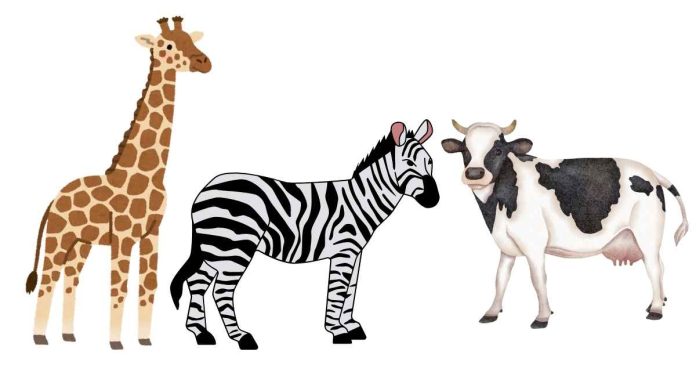The term ungulate is used to refer to a diverse group of mammals that share a common characteristic: hooves. Hooves are essentially hard, keratinized structures that cover the terminal phalanges (the last bones of the toes). This adaptation is important because hooves are highly effective for animals that need to travel long distances or support large bodies on land.
Classification of Ungulates
Ungulates are traditionally divided into two main groups based on their hoof structure and the number of toes they have:
- Perissodactyla (Odd-toed ungulates):
- These animals typically have an odd number of toes on each foot, usually one or three.
- Notable species include:
- Horses (one toe per foot)
- Zebras (one toe per foot)
- Rhinoceroses (three toes per foot)
- Tapirs (three toes on the front, four on the back)
- Perissodactyls are primarily herbivores and are often known for grazing or browsing.
- Artiodactyla (Even-toed ungulates):
- These animals have an even number of toes, usually two or four on each foot.
- Notable species include:
- Cattle (two toes per foot)
- Sheep (two toes per foot)
- Deer (two toes per foot)
- Pigs (two toes per foot)
- Giraffes (two toes per foot)
- Artiodactyls can be herbivores (like deer and giraffes), omnivores (like pigs), or have more specialized diets.
Evolution of Ungulates
Ungulates are thought to have evolved from early mammal ancestors, particularly from a group of animals known as the Condylarthra. The transition to hoofed animals likely provided advantages in terms of speed and efficiency for grazing or browsing over large distances. The development of hooves was a major evolutionary step that allowed ungulates to thrive in various environments, from grasslands to forests.
The difference between odd-toed and even-toed ungulates comes down to the structure of the limb and foot, which evolved in response to different ecological niches and pressures. For instance, odd-toed ungulates (like horses) evolved for running long distances on open terrain, while even-toed ungulates (like deer) often evolved to have better balance and maneuverability in forested or varied landscapes.
Hoof Structure
The hoof is made of keratin, the same material that makes up human nails and hair. The outer part of the hoof is called the hoof wall, and it surrounds the softer inner tissues, such as the coronary band (which helps produce new hoof material) and the sole (which supports the weight of the animal).
The shape of the hoof varies between species, often reflecting the animal’s lifestyle:
- Horses and zebras have single, large hooves designed for speed and endurance.
- Pigs and cattle have cloven hooves (split into two toes), which provide better stability on soft ground.
Importance of Hooves
Hooves are not just a form of protection for the digits; they also enhance locomotion. They are often adapted to the type of terrain the animal lives on:
- Horses evolved hooves that enable them to gallop across hard, flat ground.
- Deer have hooves that help them move silently through forests and navigate more rugged, uneven terrain.
Other Ungulate-like Traits
In addition to hooves, many ungulates share other characteristics, such as:
- A digestive system adapted for processing plant material (such as a ruminant stomach in animals like cows and deer that allows for fermentation of tough plant fibers).
- Specialized teeth for grinding plants, such as flat molars.
Modern Ungulate Diversity
Today, ungulates are incredibly diverse, ranging from the small antelopes in Africa to the massive elephants, which technically aren’t true ungulates but share many similar features (like toe-based walking and weight-bearing structures).


